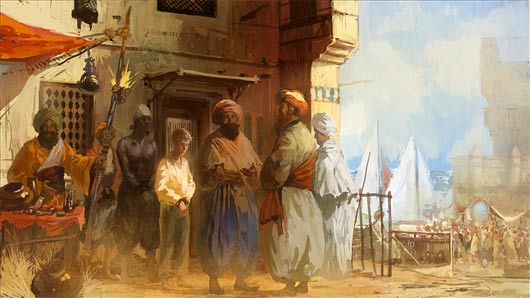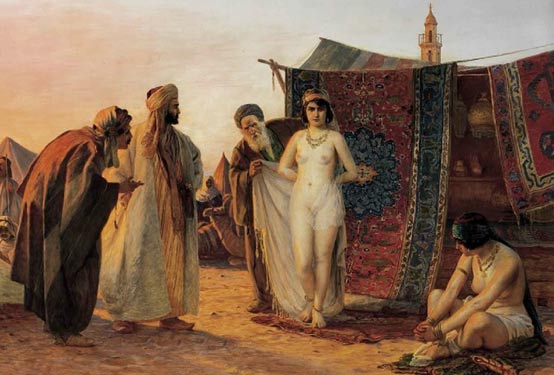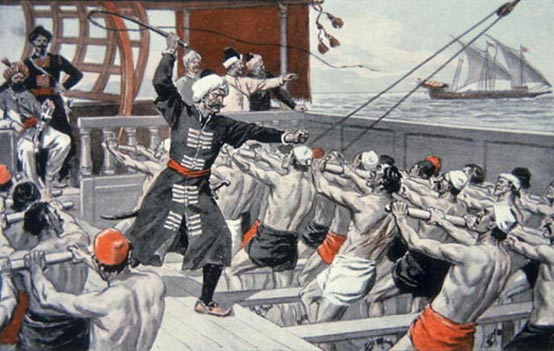The White Slaves of Barbary
Title : The White Slaves of Barbary
Link : The White Slaves of Barbary

Much attention and condemnation has been directed towards the tragedy of the African slave trade , which took place between the 16 th and the 19 th centuries. However, another equally despicable trade in humans was taking place around the same time in the Mediterranean. It is estimated that up to 1.25 million Europeans were enslaved by Barbary corsairs , and their lives were just as pitiful as their African counterparts. They have come to be known as the white slaves of Barbary.
Slavery is one of the oldest trades known to man. We can first find records of the slave trade dating back to The Code of Hammurabi in Babylon in the 18th century BCE. People from virtually every major culture, civilization, and religious background have made slaves of their own and enslaved other peoples. However, comparatively little attention has been given to the prolific slave trade that was carried out by pirates, or corsairs, along the Barbary coast (as it was called by Europeans at the time), in what is now Morocco, Algeria, Tunisia, and Libya, beginning around 1600 AD.
Anyone travelling in the Mediterranean at the time faced the real prospect of being captured by the Corsairs and taken to Barbary Coast cities and being sold as slaves.
However, not content with attacking ships and sailors, the corsairs also sometimes raided coastal settlements in Italy, France, Spain, Portugal, England, Ireland, and even as far away as the Netherlands and Iceland. They landed on unguarded beaches, and crept up on villages in the dark to capture their victims. Almost all the inhabitants of the village of Baltimore, in Ireland, were taken in this way in 1631. As a result of this threat, numerous coastal towns in the Mediterranean were almost completely abandoned by their inhabitants until the 19 th century.
The Sacking of Baltimore
The raiding of the coastal village of Baltimore on Ireland’s South West coast is one of the more horrific acts performed by the Barbary corsairs. At 2.00am on 20 June, 1631, over 200 corsairs armed with muskets, iron bars and sticks of burning wood landed on the shore of Baltimore and silently spread out, waiting at the front doors of the cottages along the shoreline and the homes in the main village. When a signal was given, they simultaneously charged into the homes, pulling the sleeping inhabitants from their beds. Twenty men, 33 women and 54 children were dragged into ships and began the long voyage back to Algiers.
Upon arrival, the citizens of Baltimore were taken to slave pens before being paraded before prospective buyers, chained and nearly naked. Men were typically used for labor and women as concubines, while children were often raised as Muslims, eventually forming part of the slave corps within the Ottoman army.

Captured victims arrive on the Barbary coast to be sold as slaves.
The Rise of the Barbary Corsairs
In the 13th and 14th centuries, it was Christian pirates, primarily from Catalonia and Sicily, that dominated the seas, posing a constant threat to merchants. It was not until the expansion of the Ottoman Empire in the 15 th century that the Barbary corsairs started to become a menace to Christian shipping.
Around 1600 AD, European pirates brought advanced sailing and shipbuilding techniques to the Barbary Coast, which enabled the corsairs to extend their activities into the Atlantic Ocean, and the impact of Barbary raids peaked in the early to mid-17th century.
While the Barbary slave trade is typically portrayed as Muslim corsairs capturing white Christian victims, this is far too simplistic. In reality, the corsairs were not concerned with the race or religious orientation of those they captured. Slaves in Barbary could be black, brown or white, Catholic, Protestant, Orthodox, Jewish or Muslim. And the corsairs were not only Muslim; English privateers and Dutch captains also exploited the changing loyalties of an era in which friends could become enemies and enemies friends with the stroke of a pen.
"One of the things that both the public and many scholars have tended to take as given is that slavery was always racial in nature,” said historian Robert Davis, author of Christian Slaves, Muslim Masters: White Slavery in the Mediterranean, the Barbary Coast, and Italy . “But that is not true," he added.
In comments which may stoke controversy, Davis claims that white slavery had been minimised or ignored because academics preferred to treat Europeans as evil colonialists rather than as victims.

The Barbary slave trade is typically depicted as Muslims capturing white Christians, such as in the artwork above, but this is not entirely accurate. Image source.
Life as a Barbary Slave
The slaves captured by the Barbary pirates faced a grim future. Many died on the ships during the long voyage back to North Africa due to disease or lack of food and water. Those who survived were taken to slave markets where they would stand for hours while buyers inspected them before they were sold at auction.
After purchase, slaves would be put to work in various ways. Men were usually assigned to hard manual labor, such as working in quarries or heavy construction, while women were used for housework or in sexual servitude. At night the slaves were put into prisons called 'bagnios' that were often hot and overcrowded. However, by far the worst fate for a Barbary slave was being assigned to man the oars of galleys. Rowers were shackled where they sat, and never allowed to leave. Sleeping, eating, defecation and urination took place at the seat. Overseers would crack the whip over the bare backs of any slaves considered not to be working hard enough.

Galley Slaves of the Barbary Corsairs. Image source .
The end of the Barbary corsairs
Corsair activity began to diminish in the latter part of the 17th century, as the more powerful European navies started to force the pirates to cease attacking their shipping. However, it wasn’t until the first years of the 19th century, that the United States of America and some European nations began to fight back more fervently against the Barbary pirates.
Algiers was frequently bombarded by the French, Spanish and Americans, in the early 19th century. Eventually, after an Anglo-Dutch raid in 1816 on Algiers, the corsairs were forced to agree to terms which included a cessation of the practice of enslaving Christians, although slave trading of non-Europeans was allowed to continue.

A Sea Fight with Barbary Corsairs, c. 1681. Image source .
Occasional incidents continued to occur until another British raid on Algiers in 1824, and finally, a French invasion of Algiers in 1830, which placed it under colonial rule. Tunis was similarly invaded by France in 1881. Tripoli returned to direct Ottoman control in 1835, before finally falling into Italian hands in the 1911 Italo-Turkish War. The slave trade finally ceased on the Barbary coast when European governments passed laws granting emancipation to slaves.
The White Slaves of Barbary
Enough news articles The White Slaves of Barbary this time, hopefully can benefit for you all. Well, see you in other article postings.
The White Slaves of Barbary
You are now reading the article The White Slaves of Barbary with the link address https://randomfindtruth.blogspot.com/2020/06/the-white-slaves-of-barbary.html